भा.कृ.अ.प. - भारतीय कृषि अनुसंधान संस्थान | ICAR-Indian Agricultural Research Institute
| हिन्दी | || || |
भा.कृ.अ.प. - भारतीय कृषि अनुसंधान संस्थान | ICAR-Indian Agricultural Research Institute
| हिन्दी | || || |

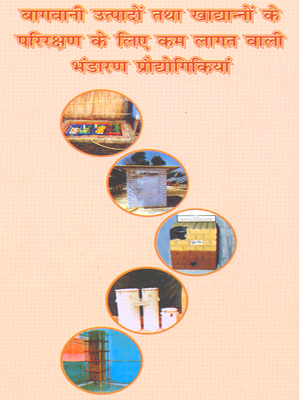 |
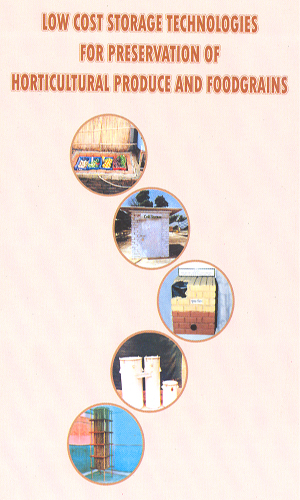 |
| Read more (Hindi)... | Read more (English)... |
Neem (Azadirachta indica A.]uss., Family: Meliaceae, Subfamily: Meliodeae, Order, Meliales) is an evergreen tree native to the Indian subcontinent. It also grows widely in several other countries of Asia, Australia, Africa and Central and South America. The tree grows on almost all kinds of soils including saline and alkali and the other wastelands. It grows as avenue, ornamental and agroforestry plantation or as shade
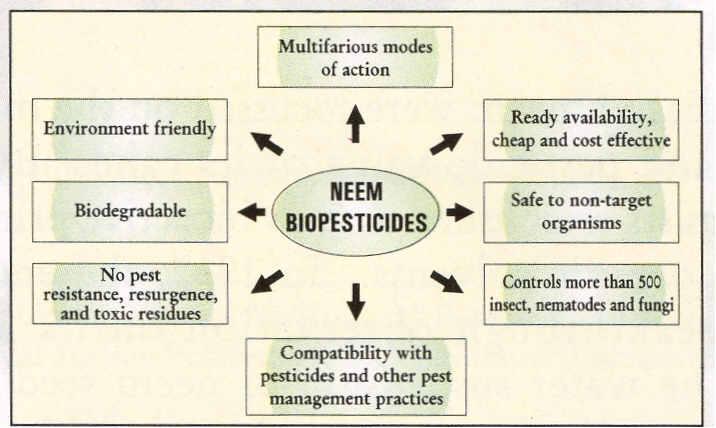
tree along roadsides. For centuries, it has been held in high esteem by Indian folk for its medicinal and insecticidal properties. Various pans of the tree have been employed to obtain medicinal preparations used in Ayurvedic and Unani systems of medicines. There is hardly a disease where the use of neem is not mentioned.
It has been an age-old practice to place its dried leaves between folds of clothes to ward off moths, insects and other pests in stored rice, wheat and other grains. It is now considered to hold a great potential as pest control agent for use in agriculture. Owing to ever increasing public concerns about the harmful effects of toxic synthetic pesticides, neem based products have virtually taken the center-stage as a possible alternative. The problems associated with synthetic pesticides such as pest resistance, environment contamination, toxic residues in food, feed and fibre, chronic toxicity, disruption of non-target organisms, etc., are practically non-existent with biopesticides based on neem. Initial studies on neem were focussed on the manurial, soil conditioning and pesticide value of its cake. By 1960, the Institute's chemists established that its bioactive principles were extractable in organic solvents. In 1962, the entomologists reported a breakthrough observation on its insecticidal application. The water suspension of neem seed kernel was observed to be antifeedant against the migratory and desert Locusts, Locusta migratoria and Schistocerca gregaria. The suspension sprayed at a concentration of 0.001 per cent on standing crops at the Institute's farm during the locust swarm in 1962 successfully protected the crops. The desert locust settled on the treated khari! crops but left without feeding. The swarm also spared neem trees standing in the vicinity. These findings attracted worldwide attention and aroused interest particularly because these coincided with the publication
of 'Silent Spring' by Rachel Carson highlighting the potential dangers of synthetic pesticides to man and his environment.
Neem is a renewable source of various useful products (Fig. 1). It finds application in medicines, soap making, pest control, nitrification inhibition, slow nutrient release manure,. cattle feed, fuel, energy, ete. It has emerged as the single most important source of pesticides and allied products. All parts of the tree such as leaf, flower, fruit, seed, kernel, bark, wood, and twig are biologically active, the maximum activity being associated with the seed kernel. Biopesticides based on neem are endowed with features of diverse activity and relative safety to non-target organisms.
A broad spectrum of activity against insects, phyto-nematodes, plant pathogens, etc., is exhibited with multifarious modes of actions. Worldwide, more than 500 pest species are controlled. Its multi-pronged effects against insects as repellent, antifeedant, oviposition deterrent, molting or growth disrupt or, sterilant, ovicide and oviposition deterrent help to effectively control a variety of farm and household insect pests and pathogens infesting agricultural, plantation and cash crops. In agriculture, neem products are valued for their effect as slow N-release materials and as nitrification inhibitor also.
The observations of the Institute's scientists on the activity of neem received initially a lukewarm response from the international community. While validation trials carried out by different national and international groups yielded inconsistent results, confirmation of the activity by Prof. H. Schmutterer's group in Germany sparked the interest of international community on this wonderful tree. Two Research Bulletins, 'Neem in Agriculture' published by the Institute in 1983 and 1993 consolidated the progress made world over. N eem Newsletter initiated in 1984 by IARI and published quarterly sustained the involvement of the global community. The tree's international recognition was borne out by a publication, "Neem: A Tree for Solving Global Problems" published by the National Academy of Sciences, USA in 1992. Subsequently, two other publications entitled "Neem: Research and Development" in 1993 and "The Neem Tree" in 1995 projected the potential of this wonder-tree. Following this, a large number of pest control and health care products started appearing in the international market. Several of these are now registered in USA and other countries for diverse applications in agriculture.
Neem contains a large number of chemically diverse and structurally complex bioactive tetranortriterpenoids commonly referred to as C-seco meliacins or limonoids. Some of the potential compounds include a number of azadirachtinoids, salannin, desacetyl salannin, nimbin, desacetyl nimbin, etc. The bioactivity related research on this plant has focussed on azadirachtin because of its abundance and unique mode of action. It does not knockdown or kill the insect instantaneously like most neurotoxic insecticides. Instead, it elicits physiological and behavioral responses in insects, which lead to their death.
The azadirachtinoids are a mixture of twelve closely related meliacins, which constitute 0.3 to 0.6% of seed kernel. Several extraction techniques using either methanol, ethanol, methyl ethyl ketone, methyl tert-butyl ether or water, or their azeotropic mixtures as solvents, and separation techniques such as column chromatography, preparative thin layer chromatography, vacuum liquid chromatography and reverse phase medium or high pressure preparative liquid chromatography have been described for obtaining major azadirachtins such as A, Band H and other bioactive meliacins. Most of the processes have been patented. While liquid chromatographic and supercritical fluid chromatographic methods have been developed for their analysis, the structures have been established by IH NMR, 13C NMR and mass spectral techniques. A number of cyclic tri- and tetrasulfides, identified from the steam distillate of the fresh matured leaves and head space volatiles of crushed seeds, have been reported to possess insect repellent and spermicidal action.
Structure-activity relationship studies on the two fragments of azadirachtin, i.e., dihydrofuranoacetal and decalin moieties, revealed that the former imparted antifeedant activity and the latter caused disruption of insect growth and development. A milestone in neem chemistry has been the synthesis of these two chemical moieties by a group of chemists led by Dr. Steven Ley at Imperial College, London.
Azadirachtin is unstable to heat, light, water, pH, microbes, etc., because of which its effective life under field conditions is short. Several attempts have been made in the past to stabilize it either by structure modification or use of UV screens and other stabilizers. Its reduced derivatives, namely, dihydro- and tetrahydro-azadirachtin are more stable to light, heat, moisture, etc., and also retain the bioactivity.
The Institute has contributed enormously in the last four decades to the research and development of neem. The chemists joined hands with biologists in unraveling the multifarious actions of neem. Extraction and isolation protocols for various bioactive neem constituents were established for the first time in most of the cases. Bioassay - guided isolation of neem pesticidal constituent was employed in collaboration with entomologists, pathologists and nematologists.
Preparation and performance of crude or standard and stable products has been the key domain of neem research and development.
Azadirachtin concentrates Insecticidal products are standardized and valued based on their azadirachtin-A content. Owing to this, there is interest in the development of such concentrates, which have become an important commodity of commerce.
Technology for the preparation of azadirachtin concentrates of varying strengths has been successfully developed. The seeds/ kernels (shade dried at ambient temperature to avoid decomposition of the active ingredients) are crushed and defatted (cold press or extraction with non-polar solvents like hexane or petroleum ether) to yield neem oil. The residual cake after extraction in a suitable solvent is partitioned in a chosen blend of organic solvents to remove water soluble carbohydrates, proteins and other unwanted polar co-extractives. The crude meliacin concentrate containing azadirachtins is worked up to obtain azadirachtin powder. The crude product can be further purified by flash chromatography, controlled precipitation and crystallization. Cost effective extraction techniques employing minimum quantity of organic solvents have been developed (Scheme-l) .
Azadirachtin powder concentrate obtained (see Scheme-l) has been further purified by column/flash chromatography, medium pressure liquid chromatography (MPLC) or two-dimensional thin layer preparative chromatography to isolate azadirachtins- A, Band H in pure form. Their structures have been confirmed by electro-spray ionization (ESI) mass spectrum which has shown molecular ion . peaks [MH]+ at m/z 721, 663, and 663, respectively, corresponding to the molecular formulae C3sH44016' C33H42014 and C33H42014 (Fig. 4). The major fragment ion peaks originated as a result of elimination of water (18 amu), acetic acid (60 amu) and tiglic acid (100 amu) units from the parent molecular ion.
Hydrogenated azadirachtins are comparatively more stable than azadirachtin. A method has been developed and
standardized for hydrogenation of azadirachtin-A concentrates to 22, 23dih ydroazadirachtin-A (Indian patent appln. No. 1590/DEL/99),and tetrah ydroazadirach tin concentrates in quantitative yields under ambient/near ambient reduction conditions (Indian patent appln. No.1126/DEL/2003) (Fig. 5). It comprises hydrogenation of technical azadirachtin concentrates of appropriate strengths in the presence of a suitable catalyst. The reaction resulted in 90% conversion yielding 65-85% product. The structures of reduced azadirachtins have been established by lHNMR and mass spectrocopy.
Excess water and salts in the soil forming the crop root zone are injurious to plants. Crop yields may drastically reduce on poorly drained soils. Under prolonged waterlogged conditions, the crops eventually die owing to lack of oxygen in the root zone. The main purpose of drainage is to provide a favourable root environment, which is conducive to the proper growth of plants. Artificial drainage is essential on poorly drained agricultural fields to ensure an optimum air-water-salt regime in the crop root zone.
 |
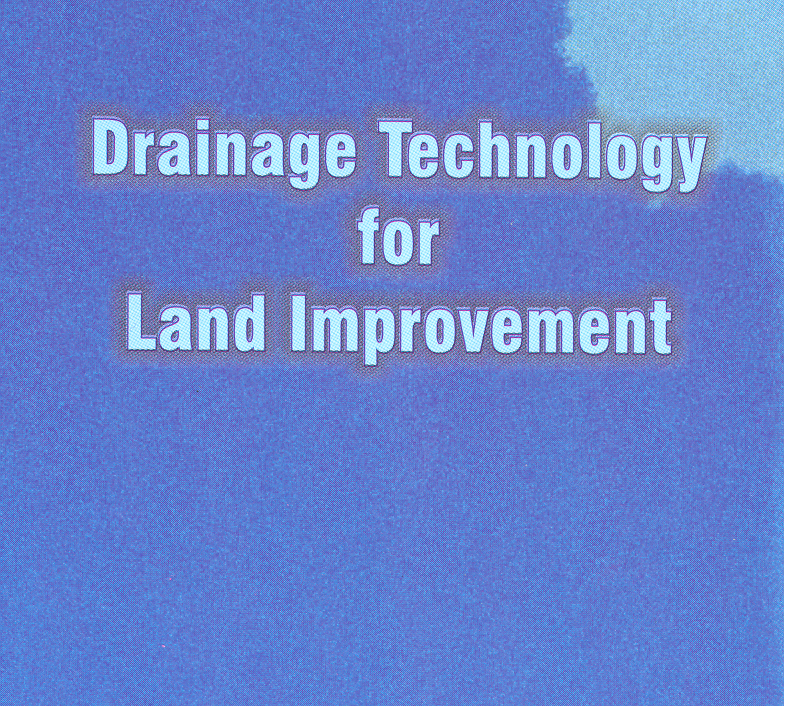 |
| Read more (Hindi)... | Read more (English)... |
The climate of earth is a dynamic one promoting the evolution of various living forms and changing the structure and chemical composition of the atmosphere. Over the past few decades, acceleration in the human-induced changes in the climate of the earth has become the focus of scientific and social scrutiny. The gaseous composition of the atmosphere has undergone a significant change mainly through increased industrial emissions, fossil fuel combustion, widespread deforestation and burning of biomass as well as changes in land use and land management practices. These anthropogenic activities have resulted in an increased emission of radiatively active gases, e.g., carbon dioxide (CO), methane (CHJ and nitrous oxide (NzO), popularly known as the 'greenhouse gases'. The atmospheric concentrations of carbon dioxide, methane and nitrous oxide were 280±6 ppm, 700±60 ppb and 270±10 ppb between the period 1000 and 1750 AD (!pCC, 2001. Climate change 2001: Impacts, adaptation and vulnerability. Inter-Governmental Panel on Climate Change, Report of the Working Group II. Cambridge, UK.) Today, these values have become 369 ppm, 1750 ppb and 316 ppb, respectively. These greenhouse gases trap the outgoing infrared radiation from the earth's surface. The process, generally referred to as the greenhouse effect, adds to the net energy of the lower atmosphere and, therefore, results in atmospheric warming. The global mean annual temperature at the end of the 20th century has increased by 0.7 DC from that recorded at the end of the 19th century. Diurnal temperature range has also decreased, with night time temperature increasing at twice the rate of day time maximum temperature. The 1990s were, on an average, the warmest decade of the earth since the starting of instrumental measurement of temperature in 1860's, and the twentieth century has been the warmest during the last 1000 years. The seven warmest years globally in the instrumental record occurred in 1990s.
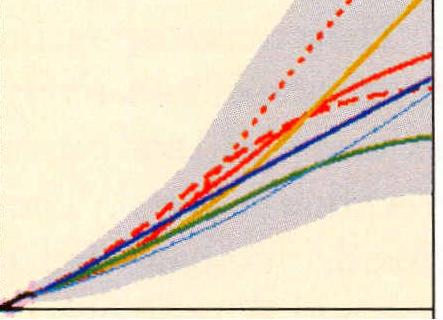
Global warming, in turn, leads to regional changes in climaterelated parameters such as rainfall, soil moisture, and sea level. The extensive and frequent occurrence of climatic extremes such as droughts, heat and floods in the last decade in many parts of the world may be the fallout of this. The sea level has risen by 10-20 cm with regional variations (!pCC 2001). Similarly, snow cover is also believed to be gradually decreasing.
The Inter-Governmental Panel on Climatic Change (!pCe) of the United Nations in its report for 2001 has projected using different models that the globally averaged temperature of the air above the earth's surface might rise by 1.4-5.8°C over the next 100 years (Fig. 1) (!pCC, 2001). The CO2 levels are projected to increase to 388-399 478-1099 by 2100 using different models. For India, the area-averaged annual mean warming by 2020 is projected to be between 1.0 and 1.4°C and between 2.2 to 2.9°C by 2050. Relatively, the increase in temperature would be less in khari! (monsoon season) than in rabi (winter season). The khari! rainfall is expected to increase in most places whereas rabi rainfall may decrease in some areas. The rabi rainfall will, however, have larger uncertainty (Table 1).
Table 1. Projected change in temperature and rainfall due to global warming in different crop seasons in 2020, 2050 and 2080s in south Asia.
|
Year |
Season |
Increase in temperature, °C |
Change in rainfall, % |
||
|
|
|
Lowest |
Highest |
Lowest |
Highest |
|
2020 |
Rabi |
1.08 |
1.54 |
-1.95 |
4.36 |
|
|
Khari! |
0.87 |
1.12 |
1.81 |
5.10 |
|
2050 |
Rabi |
2.54 |
3.18 |
-9.22 |
3.82 |
|
|
Khari! |
1.81 |
2.37 |
7.18 |
10.52 |
|
2080 |
Rabi |
4.14 |
6.31 |
-24.83 |
4.50 |
|
|
Khari! |
2.91 |
4.62 |
10.10 |
15.18 |
More floods, frequent droughts and forest fires, decrease in agricultural and aquacultural productivity, displacement of coastal dwellers by sea level rise and intense tropical cyclones, and the degradation of mangroves may be some of the likely consequences of climate change in Asia.
Such consequences could considerably affect the food supply and access through their direct and indirect effects on crops, soils, livestock, fisheries and pests. Increase in atmospheric CO2 promotes the growth and productivity of C3 OOW photosynthetic activity) plants. On the other hand increase in temperature, can reduce crop duration, increase crop respiration rates, affect the equilibrium between crops and pests, hasten nutrient mineralisation in soils, decrease fertiliser use efficiencies, and increase evapo-transpiration among others. Uncertainty in precipitation causing droughts and floods has been responsible for many famines, rural poverty and migration despite development of impressive irrigation potentials. These environmental changes, particularly temperature increase and sea level rise, could also affect fisheries directly and indirectly through changes in the availability of feed. Similarly, by increased temperatures the changes in fodder and water availability may affect production of meat and milk.
Indirectly, there may be considerable impact on agricultural land use due to snow melt, availability of irrigation, frequency and intensity of inter- and intra-seasonal droughts and floods, soil organic matter transformations, soil erosion, decline in arable areas (due to submergence of coastal lands), and availability of energy. All these changes would have tremendous impact on agricultural production and, hence, on the food security of any region. Several important socio-economic determinants of food supply such as government policies, capital availability, prices and returns, infrastructure, land reforms, and inter- and intranational trade are also expected to be influenced and altered by environmental changes.
Alarmed by the possible impact of global climatic change on the quality of life of human beings, there has been a serious concern all over the world in understanding the processes and developing strategies to mitigate the negative effects. It has been realized by all that a change in environmental quality affects all aspects of life. Efforts are, therefore, needed to reduce the emission of greenhouse gases, which are mainly responsible for atmospheric warmmg.
The solution to such environmental issues is closely linked with the issues of socio-economic problems. Each country or region addresses the problem with their own individualistic perception on what is best suited for their economic development and not necessarily what is best for the health of the world as a whole. Therefore, such environmental problems generally involve conflicts between the interests of those who benefit greatly and those who benefit less or none at all. For example, the quest for maintaining the currently unsustainable life styles by the western world prevents it from reducing energy consumption contributing to increased emissions of green house gases. On the other hand, the quest for improved income and quality of life by the developing countries forces them to increase their energy use.
The emissions of GHGs can be somewhat reduced by using cleaner technologies currently available in the western world. Such clean technologies can help the developing world in containing their GHG emissions and yet meet their developmental goals. However, the business interests of corporate bodies, who own such technologies, restrict their free sharing. Ironically, India, China and other developing countries of Asia have been blamed by the western world for their 'large' contributions to GHG emissions and thus global warming.
The total annual injection of methane into the atmosphere from all sources in the world is estimated to be 375 Tg (1 Tg = 1012 g or 1 million tonnes). Although the increase in annual load of methane in the atmosphere is much less than that of CO2, its high impaired absorption amounts to higher contribution (15-20%) in the global warming. Agriculture, largely rice paddies, and ruminant animal production, is considered a major source of this emission. Continuously flooded rice fields emit methane as anoxic conditions favour methanogenesis. International studies based on very limited measurements done in the USA and Europe and extrapolated to the whole world indicated that as much as 110 Tg per year was released from rice paddies alone (Houghton, J.T., Jenkins, G.J., and Ephraums, J.J. 1990, Climate Change. IPCC scientific assessment. Cambridge University Press). Since India and China are the major rice cultivators, US-EPA attributed 38 Tg methane per year to Indian rice fields. Based on this, the international opinion was built that Asia, in particular India and China, contributes considerably to global warming and should do something to prevent this.
It required sustained and systematic indigenous research effort to develop correct estimates of methane emissions form Indian paddies. The pioneering studies done in this context at the Indian Agricultural Research Institute since 1990 helped in rationalizing the estimates of GHG emissions and formulating our national policy on global climate change.
International concerns and conflicts on global climate change have now led to the United Nations Framework Convention on Climate Change (UNFCCC) following the Earth's Summit in June 1992. The UNFCCC, which came into force on 21st March 1994, requires all parties to compile, periodically update, and publish national inventories of GHG emission and sinks using comparable methodologies that have been agreed upon by the Conference of Parties (COP). The Indian Agricultural Research Institute (IARI) has taken a lead role in the preparation of the national inventories for methane and nitrous oxide emissions from Indian agriculture. The Institute has also been actively engaged in research to understand the greenhouse gas emission mechanisms in detail and to reduce the uncertainties in the greenhouse gas emission estimates, leading to the development of strategies to reduce the emissions. Following are the highlights of the work done in this regard.
Methanogenesis, the process responsible for methane formation, occurs in all anaerobic environments in which organic matter undergoes decomposition. Rice is generally grown in waterlogged condition, which creates an anoxic environment and is conducive to methane production by the strictly anaero bic methanogenic bacteria. Methanogens use organic compounds as electron donors for energy and synthesis of cellular constituents and, in turn, reduce C to CH4 Field and laboratory experiments were conducted at lAR! to (a) measure methane emission from rice ecosystems, (b) evaluate the effect of irrigation and fertilizer management on methane.
Viticulture in India is unique as it can be practised in almost all the climatic conditions ranging from tropical to temperate. Research work on grape was initiated with collection of germplasm, bredding of new genotypes, use of growth regulators, standardization of agro-techniques (including training, pruning, rootstcoks, water and nutrient requirements, etc.) and post harvest technology. New cultivation practices life the use of salt tolerant rootstocks, drip irrigation, etc., are being popularized. the use of rootstocks coupled with proper pruning technique has shoen enormous promise.
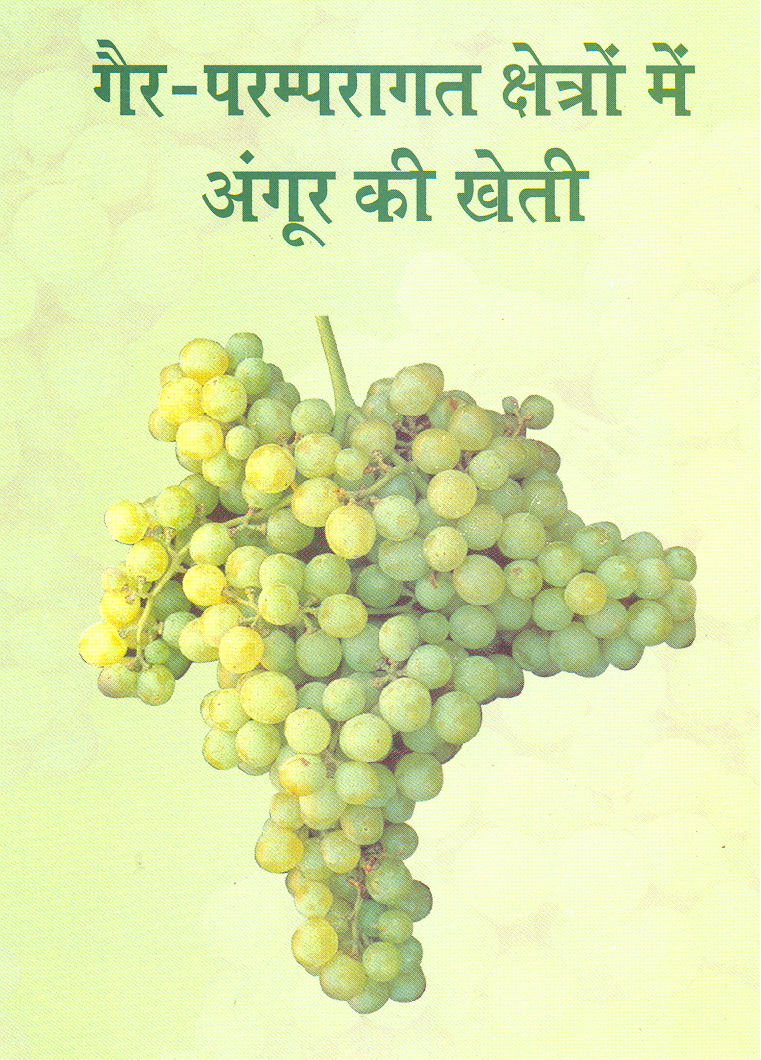 |
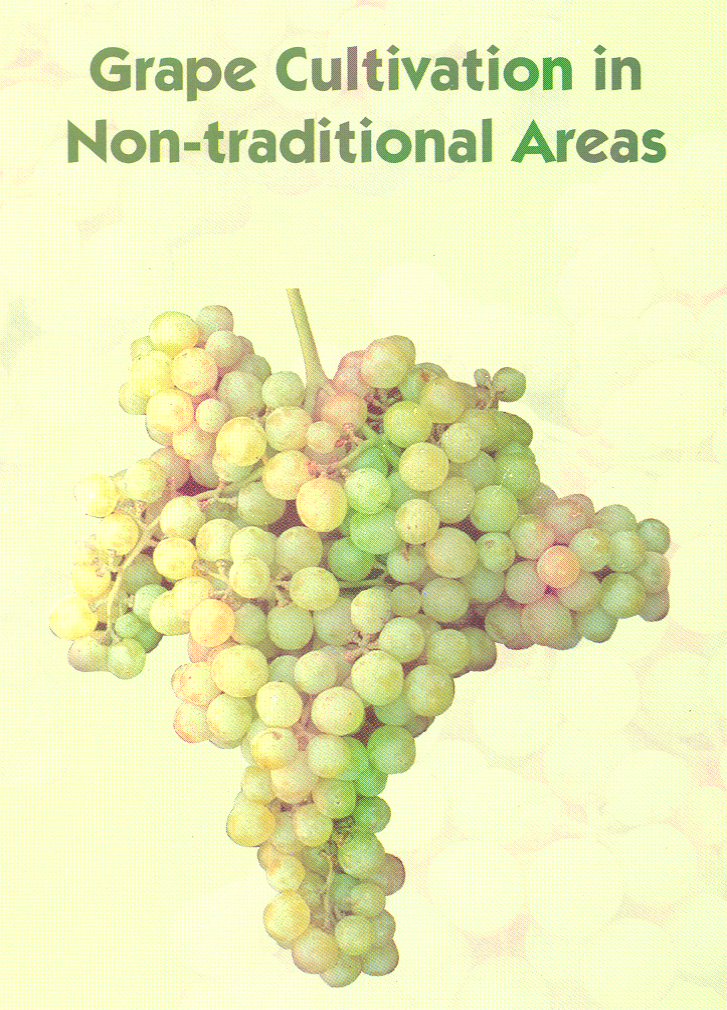 |
| Read more (Hindi)... | Read more (English)... |
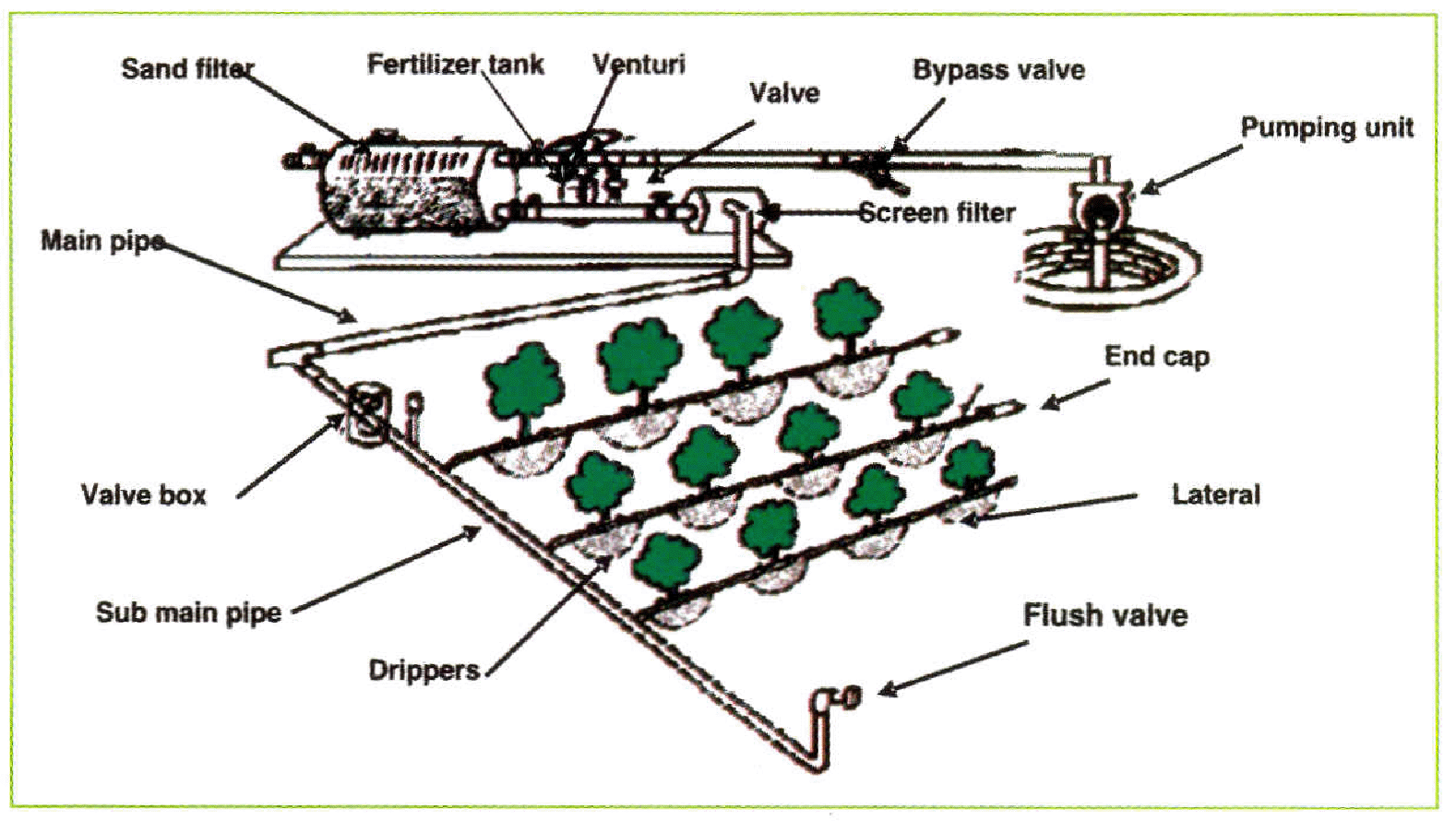
In India, the irrigated area consists of about 36 per cent of the net sown area. Presently, the agricultural sector accounts for about 83 per cent of all water uses. The remaining uses include 5, 3, 6 and 3 per cent respectively, by domestic, industrial and energy sectors and other consumers. Increasing competition with the other water users in the future would limit the water availability for expanding irrigated area. In traditional surface irrigation methods, the losses in water conveyance and application are large. These losses can be considerably reduced by adopting drip and sprinkler irrigation methods. Among all the irrigation methods, the drip irrigation is the most efficient and it can be practised in a large variety of crops, especially in vegetables, orchard crops, flowers and plantation crops. In drip irrigation, water is applied near the plant root through emitters or drippers, on or below the soil surface, at a low rate varying from 2 - 20 lit res per hour. The soil moisture is kept at an optimum level with frequent irrigations. Drip irrigation results in a very high water application efficiency of about 90-95 per cent. A typical drip irrigation system is shown in fig. 1.
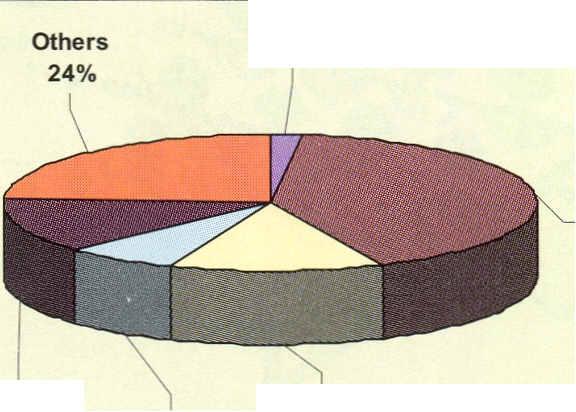 The use of drip irrigation can be traced back to the ancient custom in certain parts of India of irrigating a tulsi plant kept in the courtyard. During the summer months, the plant was irrigated by a hanging pitcher containing water and a minute hole at its bottom to allow the trickling of water on to the plant. The tribal farmers of Arunachal Pradesh practised a primitive form of drip irrigation system using a slender bamboo as the conduit for water flow. The use of drippers in sub-surface irrigation network was first experimented with in Germany in 1869. The conspicuous growth of the petrochemical industry during and after the 1950s facilitated manufacturing of plastic pipes at a cost much cheaper than the cost of metallic or cement concrete pipes. Plastic pipes are convenient for water conveyance under pressure and the plastic material are easily formed into the desired configuration. These features of plastic made the field-scale use of drip irrigation practicable. The drip system was developed for field crops in Israel in the early 1960s and in Australia and North America in the late 1960s.The area under drip irrigation system in the USA is about 1 M ha, followed by India, Spain, Israel, etc.
The use of drip irrigation can be traced back to the ancient custom in certain parts of India of irrigating a tulsi plant kept in the courtyard. During the summer months, the plant was irrigated by a hanging pitcher containing water and a minute hole at its bottom to allow the trickling of water on to the plant. The tribal farmers of Arunachal Pradesh practised a primitive form of drip irrigation system using a slender bamboo as the conduit for water flow. The use of drippers in sub-surface irrigation network was first experimented with in Germany in 1869. The conspicuous growth of the petrochemical industry during and after the 1950s facilitated manufacturing of plastic pipes at a cost much cheaper than the cost of metallic or cement concrete pipes. Plastic pipes are convenient for water conveyance under pressure and the plastic material are easily formed into the desired configuration. These features of plastic made the field-scale use of drip irrigation practicable. The drip system was developed for field crops in Israel in the early 1960s and in Australia and North America in the late 1960s.The area under drip irrigation system in the USA is about 1 M ha, followed by India, Spain, Israel, etc.
In India, there has been a tremendous growth in the area under drip irrigation during the last 15 years. At present, around 3.51akh ha area is under drip irrigation with the efforts of the Government of India, while it was only 40 ha in 1960. Maharashtra (94,000 ha), Karnataka (66,000 ha) and Tamil Nadu (55,000 ha) are some of the states where large areas have been brought under drip irrigation. Many crops are irrigated by the drip method in India with the tree crops occupying the maximum percentage of the total area under drip irrigation, followed by vine crops, vegetables, field crops, flowers and other crops, as shown in fig. 2.

The National Committee on Plasticulture Applications in Horticulture (NCPAH), Ministry of Agriculture, Government of India (GOl) has estimated a total of 27 million hectares area in the country that has the potential of drip irrigation application .
Efforts to develop and use hybrid rice technology in India were initiated at the Indian Agricultural Research Institute in early 1970's. However, systematic research work was started in 1989 under a mission mode project of ICAR. With the concerted research work, the country developed many rice hybrids, of which 23 have been officially released.
High cost of hybrid seed is one of the major constraints in the adoption of the hybrid rice technology. This is primarily attributed to the low hybrid seed yield which is around 1-1.5 t/ha. It is necessary to enhance the seed yield level to more than 2.5 t/ha in order to economise the seed cost. Currently hybrid rice seed production is taken up in the rabi season primarily in Karimnagar district of Andhra Pradesh. In this region, the seed is harvested by April-May, which after drying, processing, testing, packaging and transportation reaches north India only by the beginning of June. As the nursery sowing is taken up in this region by the end of May, the delay in the availability of hybrid seed affects the development of hybrid rice cultivation in north India.
The Division of Seed Science &: Technology of the Institute, therefore, undertook a programme on standardization of hybrid rice seed production technology in the main khari season. Concerted research carried out for more than a decade resulted in the development of an economically feasible technology for north India. The primary benefit of this technology is that the hybrid seed is harvested, processed and tested in NovemberÂDecember and stored for a short period up to March under cool and dry conditions. This seed is available to the farmers by April-May. Growing the hybrid seed in kharifseason also allows sufficient time to undertake hybrid purity testing through growout test during December-March.
Cost of the female parental lines of rice are based on wild abortive (WA) cytoplasm due to which about 25 -33 per cent of the spikelets are enclosed in the flag leaf sheath making them unavailable for pollination. Foliar application of GA} at the start of panicle emergence has been widely adopted as an essential technique for enhancing panicle excertion